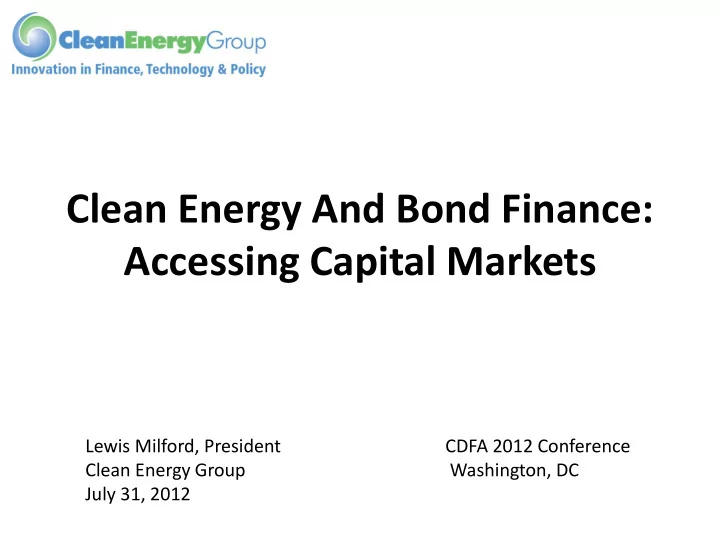

Clean Energy And Bond Finance: Accessing Capital Markets Lewis Milford, President CDFA 2012 Conference Clean Energy Group Washington, DC July 31, 2012
Cumulative U.S. Grid-tied Photovoltaic Installations (2001-2010) Source: Sherwood, Larry. “U.S. Solar Market Trends 2010”. IREC. June 2011. 2
Solar Industry Growth Source: 1976 – 1985 data from IPPC, May 2011; 1985 – 2010 data from Paula Mints, Principle Analyst, Social Services Program, Navigant; 2011 numbers based on current market data. 3
State of Energy Market: Wind America’s wind industry built 5,116 MW of wind power last year, posting 15% growth in 2010, and entered 2011 with over 5,600 megawatts currently under construction. Total U.S. wind installations stand at 40,181 MW, representing 21% of global wind capacity. 4 Source: AWEA, 2010 u.S. Wind Industry Market Update
State of Energy Market: Wind Source: AWEA, 2010 U.S. Wind Industry Market Update 5
U.S. Energy Supply Forecasts – New Capacity Additions by Sector (MW) 6
Heat Sends U.S. Nuclear Power Production to 9-Year Low “Nuclear -power production in the U.S. is at the lowest seasonal levels in nine years as drought and heat force reactors from Ohio to Vermont to slow output.” http://www.businessweek.com/news/2012-07-26/heat-sends-u- dot-s-dot-nuclear-power-production-to-9-year-low
New U.S. Clean Energy Investments 8
A 70% Funding Cliff Without Legislation Action “Beyond Boom & Bust”, Breakthrough Institute, Brookings Institution and World Resources Institute. April 2012. 9
End of Federal Programs “Beyond Boom & Bust”, Breakthrough Institute, Brookings Institution and World Resources Institute. April 2012. 10
Boom and Bust Tax Driven Industry U.S. Wind Project Installations, 1999-2005 (MW) 11
Limits to Federal Tax Equity Model 12
Bank Lending Down • The great recession of 2008 has led to reduced bank lending in the clean energy sector, among both European and American banks. • Many American banks refuse to lend beyond ten years, dealing a blow to infrastructure type investment in clean energy projects. • Result: higher lending costs and reduced capital availability. 13
Make Clean Energy Investment Boring DOE’ s Top Financing Expert Says: “Projects in the US rely upon an old fashioned and anachronistic form of financing that is different than how other parts of the US economy are financed. Rather than use bond or stock markets, projects depend on non- capital markets sources of so called tax equity, bank debt, and private equity where rates of return can approach typical private equity rates of return of 12-15 percent . [New strategies}… don’t require going to the lab; they Involve applying financing techniques that have already been invented and are used widely in other parts of the economy, but have not yet been applied to this sector.” Comments of Richard Kaufman, Special Adviser to Secretary Chu (July 25, 2012), in a public note to colleagues in the field. 14
New National Partnership of CEG and CDFA 15
CE+BFI • CE+BFI: The Clean Energy Group (CEG) and the Council of Development Finance Agencies (CDFA) will announce tomorrow the Clean Energy + Bond Finance Initiative (CE+BFI). The CE+BFI will work with public infrastructure finance agencies, clean energy public fund managers and institutional investors across the country to explore how to raise capital at scale for clean energy through bond financing. • Goal: increasing clean energy investment from $5 to $20 billion in the next five years through bond financing • Task Force : includes over 50 representatives from the top public and private clean energy and development finance organizations throughout the country, including DOE, states, cities, law firms, private banks, and other clean energy and bond finance industry professionals. 16
CE+BFI To achieve these goals, the first priority of CE+BFI is to scale up the use of existing development finance tools for clean energy. This would not require changes in law, reliance on new policies, or creation of new institutions. It would be a matter of bringing the existing partners together to work on creating new opportunities and investments with existing bond tools. 17
Contact Info Lewis Milford Clean Energy Group 50 State Street, Suite 1 Montpelier, VT 05602 Phone: 802-223-2554 Email: LMilford@cleanegroup.org
Recommend
More recommend